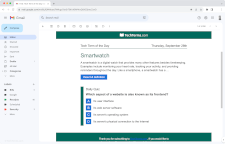Webmail
Webmail refers to email services that provide a web-based interface instead of (or in addition to) using a local email client application. Many webmail services are free or offer a mix of free and paid service tiers. The most common webmail providers include Gmail, Outlook.com (formerly Hotmail), Yahoo! Mail, and iCloud Mail. However, if you own your own domain, many web hosts offer a webmail interface for sending and receiving email through your domain's email addresses.
Using webmail for your email account can be a lot more convenient than using an email client app. You can access your email from any computer or mobile device as long as it has an Internet connection and a web browser. There's no software to install, and setup is usually as simple as choosing a unique email address and setting a password. All activity is automatically synced to the mail server, so when you read a message on one device, it is marked as read when you check your inbox from another device later. Most webmail services also provide automatic spam filtering for your inbox and virus scanning for attachments you receive.
However, the convenience of webmail comes with tradeoffs. Accessing your webmail requires an active Internet connection, so if you're offline, you won't be able to view already-delivered messages. Your webmail account also relies solely on the cloud storage offered by the provider, and while some services are generous with the space they offer, storage space is not unlimited. You can download and archive messages from a webmail account through a web browser, but it's often a more cumbersome process than archiving messages using an email client.
 Test Your Knowledge
Test Your Knowledge